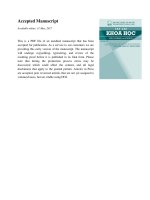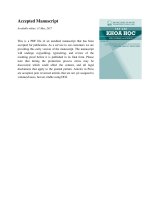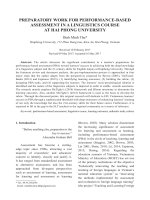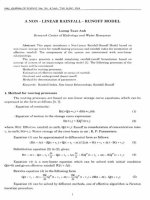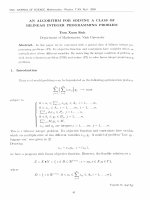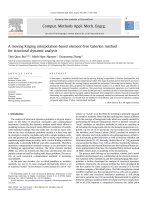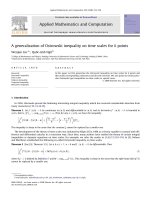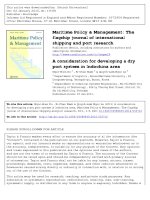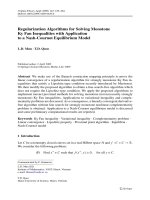DSpace at VNU: A Model for Real-time Concurrent Interaction Protocols in Component Interfaces
Bạn đang xem bản rút gọn của tài liệu. Xem và tải ngay bản đầy đủ của tài liệu tại đây (153.12 KB, 9 trang )
Accepted Manuscript
Available online: 31 May, 2017
This is a PDF file of an unedited manuscript that has been
accepted for publication. As a service to our customers we are
providing this early version of the manuscript. The manuscript
will undergo copyediting, typesetting, and review of the
resulting proof before it is published in its final form. Please
note that during the production process errors may be
discovered which could affect the content, and all legal
disclaimers that apply to the journal pertain. Articles in Press
are accepted, peer reviewed articles that are not yet assigned to
volumes/issues, but are citable using DOI.
VNU Journal of Science: Comp. Science & Com. Eng. Vol. 33, No. 1 (2017) 8–15
A Model for Real-time Concurrent Interaction Protocols in
Component Interfaces
Van Hung Dang∗, Trinh Dong Nguyen, Hoang Truong Anh
University of Engineering and Technology, VNU, Hanoi, Vietnam
Abstract
Interaction Protocol specification is an important part for component interface specification. To use a component,
the environment must conform to the interaction protocol specified in the interface of the component. We give
a powerful technique to specify protocols which can capture the constraints on temporal order, concurrency, and
timing. We also show that the problem of checking if a timed automaton conforms to a given real-time protocol is
decidable and develop a decision procedure for solving the problem.
Received 21 February 2017, Revised 27 February 2017, Accepted 27 February 2017
Keywords: Interaction Protocol, Timed Automata, Region Graph, Component Interface
1. Introduction
where a service from a component may take long
time to finish.
An interaction protocol specified in the interface
of a component is a precondition on the temporal
order on the use of services from the component.
Fail to satisfy this precondition may lead to a
system deadlock [2]. In real-time systems, when
a service from a component takes a considerable
time to carry out, too frequently calling to this
service may lead to the error state too. So, we
need to specify the minimum duration between
two consecutive calls to the services that takes
time, and this also plays a role of precondition
on the consecutive calls to those services in the
interaction protocols. Another possibility that we
need to consider when specifying this kind of time
constraints is that a component may be able to
provide services in parallel. In this case, time
constraints do not apply to concurrent services.
Let us consider an example. Imagine that we
have a software component that provide accesses
Component-based system architectures have
been an efficient divide-and-conquer design
technique for the development of complex realtime embedded systems. A key role in this
technique is component interface modeling and
specification. There have been many significant
progresses towards a comprehensive theory for
interfaces, see for example [2, 6, 7, 3, 5]. In
those works different aspects of interfaces have
been modeled and specified such as interaction
protocols, contracts, concurrency, relations,
synchnony and asynchrony. An approach that
integrates all those aspects has been introduced in
[4]. However, there has not been an intuitive and
powerful model for real-time interaction protocols.
This kind of model plays an crucial role in systems
∗
Corresponding author. Email.:
/>
8
Van Hung Dang et al. / VNU Journal of Science: Comp. Science & Com. Eng. Vol. 33, No. 1 (2017) 8–15
to two files: one stores the information about
products and the other stores the information about
customers. To access to a file, one needs to open
it, and after use one needs to close it. Accesses
to different files can be done in parallels, and
access can be reads and writes such that all the
reads should be before writes. Let us denote
by O p , R p , W p and C p the accesses open, read,
write and close for the file 1 (for products), and
by Oc , Rc , Wc and Cc the accesses open, read,
write and close for the file 2 (for customers).
To use the component we need to activate it by
action A, and we need to deactivate it by action
F after use. The interaction protocol could be
specified by two regular expressions to express the
condition on the temporal order between actions
on each file. These regular expressions could
be (A(O p R p W pC p )∗ F)∗ and (A(Oc Rc WcCc )∗ F)∗ .
Does the execution AO p Oc R p Rc Wc W pC pCc F
conform to this protocol? It does because it
satisfies the restriction on the temporal order for
each file. Now, assume that it takes 1 second for
the read accesses, then the execution will satisfy
the protocol if the delays between R p and W p (not
R p and Rc ; these can be done in parallel), and Rc
and Wc are more than 1 second.
In this work, we propose a technique to
specify real-time concurrent interaction protocols
for component interfaces that is an efficient
formalization of the specification from the example
mentioned above, and define formally what we
mean by saying a real-time execution conforms
to an interaction protocol in our model. Then
we develop a technique to check if a real-time
system modeled by a timed automaton satisfies a
real-time concurrent interaction protocol specified
in the interface of a component.
The paper is organized as follows. The next section
presents our general model for real-time concurrent
interaction protocols. Section 3 presents an algorithm to
check if a timed automaton satisfies a protocol specification.
The last section is the conclusion of our paper.
9
2. General Protocol Model
Let Σi , i = 1, . . . , k be alphabets of service
names for a component C, and let Ω = ki=1 Σi
be the alphabet of all service names that the
component provides. Our intention is that services
in each Σi need to be executed sequentially, and
services in different Σi and Σ j can be executed in
parallel. Each Σi , i = 1, . . . , k can overlap another,
but they must not be included in each other, i.e.
Σi is a maximal set of services that need to be
executed in sequence. When k = 1 there is no
concurrency for the component. Each service in Ω
may take time to finish. We specify this fact by a
function δ : Ω → R≥ . So, a service a ∈ Ω takes
δ(a) time units to finish. An interaction protocol
specifies a constraint on the temporal order on the
services in each separate Σi , and this is modeled
efficiently by a regular expression on Σi . Therefore,
we define:
Definition 1 (Real-time interaction protocol).
A real-time interaction protocol π is a tuple
(Σ1 , R1 ), . . . , (Σk , Rk ), δ , where δ : ki=1 Σi → R≥ ,
and Ri is a regular expression on Σi for
i = 1, . . . , k.
Example. In the example introduced in the
Introduction of this paper,
(Σ1 , R1 ) = ({A, O p , R p , W p , C p , F},
(A(O p R p W pC p )∗ F)∗ ) and,
(Σ2 , R2 ) = ({A, Oc , Rc , Wc , Cc , F},
(A(Oc Rc WcCc )∗ F)∗ ).
δ(R p ) = δ(Rc ) = 1, and δ(X) = 0 for all other
services X.
Let, in the sequel, for the simplicity of the
presentation, for a regular expression R we
overload R to denote also the language generated
by R, and when R is the language generated by R
can be understood from the context. Note that a
regular expression can always be represented by
an automaton.
10
Van Hung Dang et al. / VNU Journal of Science: Comp. Science & Com. Eng. Vol. 33, No. 1 (2017) 8–15
This definition gives a simple syntax
representation for real-time protocols.
To
understand the meaning of this representation we
need to define what to mean by saying a real-time
execution conforms to a protocol in our model.
We will use a timed automaton as our system
model, and therefore, use a timed language to
represent the behavior of our system.
A timed word over an alphabet Ω is a sequence
w = (a1 , t1 )(a2 , t2 ) . . . (an , tn ), where ti−1 ≤ ti
for 0 < i ≤ n, t0 = 0. The intuition of this
representation for a behavior is that the action ai
takes place at time ti . Given a protocol π as in
Definition 1, how to mean that w conforms to π?
Let us denote untimed(w) = a1 a2 . . . an . For a
word x ∈ Ω∗ we denote x|Σi the projection of x on
Σi , i.e. the word obtained from x by removing all
the characters that do not belong to Σi .
Definition 2 (Conformation). A timed word w =
(a1 , t1 )(a2 , t2 ) . . . (an , tn ) conforms protocol π,
denoted by w |= π, iff for all i ≤ k
1. untimed(w)|Σi ∈ Ri , and
2. let untimed(w)|Σi = a j1 . . . a jmi , then t jl+1 −
t jl ≥ δ(a jl ) for all l < mi .
The first condition in the definition says that the
temporal order between sequential services is
allowed by the component and reach an acceptance
state of the component, and the second condition
says that the component has been given enough
time for providing the services. According to this
definition, the behavior
(A, 0)(O p , 0)(Oc , 0)(R p , .5)(Rc , 1)(Wc , 2)
(W p , 2)(C p , 2)(Cc , 2)(F, 3)
when there is no constraint for temporal order
on Σi and acceptance state the regular expression
Ri = Σ∗i .
Given a component C with the protocol
specification π in its interface, a design of a system,
in order to use the services from C, all the accepted
behaviors of the system design need to conform to
π. The best model of real-time systems is timed
automata model [1] to the best of our knowledge.
Now the question of the pluggability of a real-time
environment to component C is to decide whether
all the members of the timed language of a given
timed automaton A conform to the protocol π. If
it is the case, we write A |= π for short.
3. Checking the Pluggability
In this section we present a technique to solve
the problem mentioned in the last section. Namely,
we will prove that it is decidable if all the accepted
behaviors of a timed automaton A conform to a
real-time concurrent interaction protocol π. Then
we develop an algorithm to check if A |= π. The
algorithm serves for answering the question if the
component C can fit to our design. For simplicity,
we now restrict ourselves to the case that the value
of function δ in π is integers.
Since the concept of timed automata may not be
familiar to some readers, we recall this concept
from [1]. A timed automaton is a finite state
machine with an additional set of clock variables
X and an additional set of clock constraints.
A clock constraint φ over X is defined by the
following grammar:
φ = x ≤ n | x ≥ n | ¬φ | φ1 ∧ φ2 ,
conforms to the protocol in Example 2. However,
(A, 0)(O p , 0)(Oc , 0)(R p , .5)(Rc , 1)(Wc , 1.5)
(W p , 2)(C p , 2)(Cc , 2)(F, 3)
does not as 1.5 − 1 < δ(Rc ).
From the semantics of a protocol π, when no
services can be executed in parallel k = 0, and
where x ∈ X and n stands for a natural number. Let
Φ(X) denote the set of all clock constraints over X.
Definition 3 (Timed automata). A
automaton M is a tuple
L, sI , Σ, X, E, F , where
timed
Van Hung Dang et al. / VNU Journal of Science: Comp. Science & Com. Eng. Vol. 33, No. 1 (2017) 8–15
• L is a finite set of locations,
• sI ∈ L is an initial location,
• Σ is a finite set of labels,
• X is a finite set of clocks,
• E ⊆ L × Σ × Φ(X) × 2X × L is a finite set
of transitions. An e = s, a, φ, λ, s ∈ E
represents a transition from location s to
location s , labeled with a; s and s are
called source and target locations of e, and
−
−e respectively; φ is a clock
denoted by ←
e and →
constraint over X that must be satisfied when
the transition e is enabled, and λ ⊆ X is the
set of clocks to be reset by e when it takes
place. In the sequel, we will use the subscript
e with φ and λ to indicate that φ and λ are
associated to e.
• F ⊆ L is the set of acceptance locations.
In this paper, for simplicity, we only consider
the deterministic timed automata, i.e. those timed
automata which do not have more than one alabeled edge starting from a location s for any
label a ∈ Σ.
A clock interpretation ν for a set of clock X is
a mapping ν : X → Reals, i.e. ν assigns to each
clock x ∈ X the value ν(x). A clock interpretation
represents the values of all clocks in X at a time
point. We adopt the following denotations. ν0
always denotes the clock interpretation which
maps from X to {0}. For a clock interpretation ν
and for t ∈ R, ν + t denotes the clock interpretation
which maps each clock x ∈ X to the value ν(x) + t.
For λ ⊆ X, [λ → 0]ν is the clock interpretation
which assigns 0 to each x ∈ λ and agrees with ν
over the rest of the clocks.
A state of a timed automaton M is a pair s, ν ,
where s ∈ L and ν is a clock interpretation for X.
The fact that M is in a state s, ν at a time instant
means that M stays in location s with all clock
values agreeing with ν at that instant.
11
The behavior of timed automata can be
represented by timed words (or timed-stamped
transition sequences).
A behavior σ is a
timed word
σ = (e1 , τ1 )(e2 , τ2 ) . . . (em , τm ), where m ≥ 1
→ = ←
e−i−1
e−i for 1 ≤ i ≤ m (with
and ei ∈ E, −
−
the convention →
e0 = sI ), and where 0 = τ0 ≤
τ1 ≤ τ2 ≤ . . . ≤ τm , such that (νi−1 + τi − τi−1 )
satisfies φei for all 1 ≤ i ≤ m, where νi = [λei →
0](νi−1 + τi − τi−1 ) for 1 ≤ i ≤ m.
So, a behavior σ expresses that M starts from
−
the initial location sI , transits to →
e1 by taking e1
→
−
at time τ1 , then transits to e2 by taking e1 at time
→ at time
τ2 , and so on, and at last transits to e−
m
τm . Note that (νi−1 + τi − τi−1 ) is the value of the
clock variables just before ei ’s taking place, and
νi is the value of the clock variables just after ei ’s
taking place. The behavior σ expresses also that
−
the system M stays in the location ←
e i for τi − τi−1
←
−
time units, and then transits to e i+1 for (1 ≤ i ≤
m). If σ = (e1 , τ1 )(e2 , τ2 ) . . . (em , τm ) is a behavior
of timed automaton M, we call −
e→
m a reachable
−
→
location of M and em , νm a (discrete) reachable
state of M. A behavior of timed automaton M is
→
−
accepted iff −
e→
m ∈ F . Let si = ei , for 1 ≤ i ≤ m,
and s0 = sI . Then the run corresponding to σ is
the sequence:
s0 , ν0 −→eτ11 s1 , ν1 −→eτ22 . . .
−→eτmm sm , νm .
The finite language of M is the set of all accepted
behaviors of M.
In order to solve the emptiness problem for
a timed automaton, Alur and Dill [1] have
introduced a finite index equivalence relation over
the state space of the automaton. The idea is to
partition the set of the clock interpretations into a
number of regions so that two clock interpretations
in the same region will satisfy the same set of
clock constraints.
For each x ∈ X, let K x be the largest integer
constant occurring in a clock constraint for the
12
Van Hung Dang et al. / VNU Journal of Science: Comp. Science & Com. Eng. Vol. 33, No. 1 (2017) 8–15
clock variable x of the timed automaton M, i.e.
K x = max{a | either x ≤ a or
x ≥ a occurs in a clock constraint .
of φ of a transition e}.
Let KX = max x∈X K x .
For a real number r, let frac(r) = r − r ( r is
the maximal integer number which is not greater
than r) be the fractional part of x. The equivalence
relation over the set of clock interpretations is
defined as follows: for two clock interpretations
ν and ν , ν ν iff the following three conditions
are satisfied:
1. For all x ∈ X either ν(x) > K x ∧ ν (x) > K x
or ν(x) = ν (x) .
2. For all x, y ∈ X such that ν(x) ≤ K x
and ν(y) ≤ Ky , frac(ν(x)) ≤ frac(ν(y)) iff
frac(ν (x)) ≤ frac(ν (y)).
3. For all x ∈ X such that ν(x) ≤ K x ,
frac(ν(x)) = 0 iff frac(ν (x)) = 0.
When ν ν , it is not difficult to see that for
any clock constraint φ occurring in a transition
e = s, a, φ, λ, s ∈ E, ν satisfies φ iff ν satisfies φ.
A clock region for M is an equivalence class
of the clock interpretations induced by . We
denote by [ν] the clock region to which a clock
interpretation ν belongs. From the definition of ,
a region is characterized by the integer part of the
value of each clock x when it is not greater than
K x , by the order between the fraction part of the
clocks when they are different from 0. Therefore,
the number of clock regions is bounded by |X|! ·
2|X| · x∈X (2K x + 2). A configuration is defined as
a pair s, α where s ∈ L and α is a clock region.
Based on the clock regions, the region automaton
of M, whose states are configurations of M, and
whose transitions are the combination of a time
transition and a action transition from M. There is
a time transition from s, α to s, β iff β = α+t for
some t (here for α = [ν] we define α + t = [ν + t]).
Definition 4 (Region automata). Given a timed
automaton M as in Definition 3, the region
automaton of M is the automaton R(M) =
L , sI , Σ, E , F , where
• The set of states L
configurations of M,
consists of all
• sI = sI , [νθ ] where νθ is the clock valuation
that assigns 0 to all clock variables in X,
• E is the set of transitions of R(M) such that
a transition ((s, α), a, (s , β)) ∈ E iff there is
a timed transition from s, α to s, α and
a transition in M s, a, φ, λ, s such that α
satisfies φ and β = [λ → 0]α ,
• F ⊆ L such that s ∈ F iff s = s, α
where s ∈ F and α is a clock region.
Note that R(M) is a ‘untimed’ automaton, and we
also denote its (untimed) language by L(R(M)).
We can simplify the automata M and R(M) such
that all states (locations) are reachable and all
states can lead to an acceptance state.
We recall some results from the timed automata
theory [1] that will be used in our checking
procedure later. Let L(M) denote the ω-timed
language (language of infinite timed words)
generated by M (by adding -transitions from
a final state to itself we can extend the finite
language of M to the ω language).
Theorem 1.
1. For
the
timed
automaton
M,
untimed(L(M)) = L(R(M)). Therefore,
the emptiness problem for M is decidable.
2. If s0 , ν0 −→eτ11 s1 , ν1 −→eτ22 . . . −→eτmm
sm , νm is a run from the initial state of
M then s0 , [ν0 ] −→e1 s1 , [ν1 ] −→e2
. . . −→em sm , [νm ] is a run of R(M), and
reversely, if s0 , [ν0 ] −→e1 s1 , [ν1 ] −→e2
. . . −→em sm , [νm ] is a run in R(M) then
there are τ1 , . . . , τm such that s0 , ν0 −→eτ11
Van Hung Dang et al. / VNU Journal of Science: Comp. Science & Com. Eng. Vol. 33, No. 1 (2017) 8–15
s1 , ν1 −→eτ22 . . . −→eτmm sm , νm is a run from
the initial state of M.
Let in the sequel, for an automaton M the size
of M (the number of transitions and locations) be
denoted by |M|.
Now, we return to the problem to decide
if untimed(L(A))|Σi ⊆ Ri for a given timed
automaton A. It turns out that this problem is
solvable, and just a corollary of Theorem 1.
Theorem 2.
Given a regular expression
Ri and a timed automaton A the problem
untimed(L(A))|Σi
⊆
Ri is decidable in
O(|R(A)|.|Ri |) time.
Proof. Let B be an automaton that recognizes
all the strings on Σi that do not belong to Ri ,
i.e. an automaton that recognizes the complement
R¯i of Ri . The synchronized product B ×Σi R(A)
recognizes the language R¯i ||L(R(A)) ({w | w|Σi ∈
R¯i ∧ w|Σ ∈ L(R(A))}). It follows Theorem 1 that
R¯i ||L(R(A)) = R¯i ||untimed(L(A)). The emptiness
of the language generated by B×R(A) is decidable
in O(|R × R(A)|) time. But R¯i ||untimed(L(A))
is empty if and only if untimed(L(A))|Σi ⊆ Ri .
Hence, the theorem is proved.
Now we consider the problem to decide if all
the strings generated by A satisfy the second
item of Definition 2. Let A = L, sI , Σ, X, E, F .
Let Σi ⊆ Σ. Let ci be a new clock variable,
ci
X. Define A to be the automaton that is
the same as A except that transitions with label
in Σi will have to reset the clock ci as well, i.e.
A = L, sI , Σ, X ∪ {ci }, E , F , and E = {e =
(s, a, φ, C ∪ {ci }, s ) | e = (s, a, φ, C, s ) ∈ E ∧ a ∈
Σi } ∪ {e = (s, a, φ, C, s ) | e = (s, a, φ, C, s ) ∈
E ∧a
Σi }. We illustrate the difference of
transitions in A and A in Fig. 1.
Since clock variable ci does not appear in any
guard φ of A, the automaton A generates the
same timed language as A does. Adding the
clock variable ci is just for the purpose of counting
13
time between two (consecutive) transitions in Σi .
A clock valuation for A now is of the form
ν∪{ci → v} for some v ∈ Reals. Now we construct
the region graph R(A ) for A , and analyze this
graph to see if the second condition of Definition 2
is violated by a timed word from L(A). If δ(a) = 0
for all a ∈ Σi , then the second condition for i is
satisfied trivially. Otherwise, Theorem 1 gives that
this condition is violated if and only if there is
a run s0 , [ν0 ] −→e1 s1 , [ν1 ] −→e2 . . . −→em
sm , [νm ] in R(A ) in which there are two
transitions el and el+h corresponding to resetting
clocks ci in A : el = ( sl , [νl ] , a, sl+1 , [νl+1 ]
where a ∈ Σi , νl+1 (ci ) = 0, and el+h =
( sl+h , [νl+h ] , b, sl+h+1 , [νl+h+1 ] where b ∈ Σi ,
νl+h+1 (ci ) = 0, and transitions el+1 , . . . , el+h−1
do not have label in Σi (not corresponding to
transitions in A resetting clock ci ) that makes
the following condition satisfied: Let the run in
A according to Theorem 1 corresponding to that
path be
sl , νl −→eτll . . . −→eτl+h−1
l+h−1
sl+h , νl+h −→eτl+h
sl+h+1 , νl+h+1
l+h
Then, νl+h (ci ) + τl+h < δ(a). This implies the
following: After having removed all non-reachable
states from R(A ), and adding time transitions
(labeled with “time”) to R(A ), we have that there
is also a path in R(A )
sl , [νl ] −→el . . . −→el+h−1
sl+h , [νl+h ] −→time
sl+h , [νl+h + τl+h ] −→el+h sl+h+1 , [νl+h+1 ]
in which νl+h (ci ) + τl+h < δ(a) where a is the
label of el , and el+h has label in Σi . A path in
R(A ) satisfying this condition is called “violation”
path. Now, checking for the violation of the
second condition of Definition 2 from A is done
by searching in the graph of R(A ) for a single
path (not containing a loop) from el to el+h with
the violation property as mentioned above (we call
it violation path). If no such a path found, then
14
Van Hung Dang et al. / VNU Journal of Science: Comp. Science & Com. Eng. Vol. 33, No. 1 (2017) 8–15
a
c
x:=0
s1
s3
y=1
x>=2
a
c
x:=0
s1
s2
x>=2
b
y:=0
s2
ci:=0
y=1
b
x<=5
Fig. 1. Transitions in A and A : a, b ∈ Σi , c
the timed language L(A) satisfies the condition.
This can be done in O(|R(A )|2 ) time. Therefore,
we have:
Theorem 3. The problem “if a given timed
automaton A conforms to a real-time concurrent
interaction protocol π” is decidable in time
O(|R(A )|2 ).
We sumarizes our results in the following
deciding procedure:
Algorithm (Deciding if a timed automaton
satisfies a real-time interaction protocol)
Input: A
real-time
protocol
π
=
(Σ1 , R1 ), . . . , (Σk , Rk ), δ ,
where δ : ki=1 Σi → N≥ , and Ri is a regular
expression on Σi for i = 1, . . . , k.
A timed automaton A = L, sI , Σ, X, E, F
that satisfies Σi ⊆ Σ for all i ≤ k.
Output: “Yes” if L(A) |= π, “no” otherwise.
s4
x<=5
y:=0
s3
y:=0
y:=0
ci:=0
s4
Σi
Bi ) is not empty for some i, stop with
output “no”.
3. If there is no time constraint in π,
i.e. δ is 0 mapping on Σ, stop with
output “yes”.
4. For each i = 1, . . . , k, where δ is
not a 0-mapping on Σi , construct the
timed automaton
A = L, sI , Σ, X ∪ {ci }, E , F , where
E = {e = (s, a, φ, C ∪ {ci }, s ) | e =
(s, a, φ, C, s ) ∈ E ∧ a ∈ Σi } ∪ {e =
(s, a, φ, C, s ) | e = (s, a, φ, C, s ) ∈ E ∧
a Σi }, and then construct the region
graph R(A ). Add all “time” transitions
to R(A ) and simplify it by removing
all nonreachable states. Search in R(A )
for a single violation path. If such a
path is found for some i, stop with the
output “no”.
5. Stop with the output “yes”.
Methods:
1. Construct the region automaton of A,
namely the automaton R(A).
2. For each i = 1, . . . , k construct automata
Bi that recognizes regular language
R¯i . Then, construct the synchronized
product R(A) ×Σi Bi and check if
L(R(A)×Σi Bi ) is empty. If L(R(A)×Σi
Note that a concurrent real-time system can
be modeled as a timed automata network which
is a synchronized product of a number of timed
automata, where the concurrency can be expressed
explicitly. A synchronized product of a number
of timed automata is also a timed automaton,
and hence, our algorithm works also on timed
automata networks.
Van Hung Dang et al. / VNU Journal of Science: Comp. Science & Com. Eng. Vol. 33, No. 1 (2017) 8–15
4. Conclusion
We have proposed a simple but powerful
technique to specify interaction protocols for the
interface of components. Our model can specify
many aspects for interaction: the temporal order
between services, concurrency for services, and
timing constraints. We also have shown that
the problem of checking if a timed automaton
conforms to a given real-time protocol is decidable,
and developed a decision procedure for solving
the problem. The complexity of the procedure
is proportional to the size of the region graph of
the input timed automaton which is acceptable for
many cases (like the way that the tool UPAAL
handles systems). We will incorporate this
technique to our model for real-time componentbased systems in our future work. We believe
that our results can be extended to the cases in
which systems are modeled by timed automata
with parameters, i.e. timed automata where a
parameter can appear in guards and can be reset
by a transition.
Acknowledgments
This research was funded by Vietnam
National Foundation for Science and Technology
15
Development (NAFOSTED) under grant number
102.03-2014.23.
References
[1] R. Alur and D.L. Dill. A Theory of Timed Automata.
Theoretical Computer Science, pages 183–235, 1994.
[2] Luca de Alfaro and Thomas A. Henzinger. Interface
Automata. In ACM Symposium on Foundation of
Software Engineering (FSE), 2001.
[3] Jifeng He, Zhiming Liu, and Xiaoshan Li. rCOS: A
refinement calculus of object systems. Theor. Comput.
Sci., 365(1-2):109–142, 2006. UNU-IIST TR 322.
[4] Dang Van Hung and Hoang Truong. Modeling and
specification of real-time interfaces with UTP. In
Theories of Programming and Formal Methods - Essays
Dedicated to Jifeng He on the Occasion of His 70th
Birthday, pages 136–150, 2013.
[5] Hung Ledang and Dang Van Hung. Timing and
concurrency specification in component-based real-time
embedded systems development. In TASE, pages 293–
304. IEEE Computer Society, 2007.
[6] Stavros Tripakis, Ben Lickly, Thomas A. Henzinger, and
Edward A. Lee. On relational interfaces. In EMSOFT’09,
pages 67–76. ACM, 2009.
[7] Dang Van Hung. Toward a formal model for component
interfaces for real-time systems. In Proceedings of the
10th international workshop on Formal methods for
industrial critical systems, FMICS ’05, pages 106–114,
New York, NY, USA, 2005. ACM.
